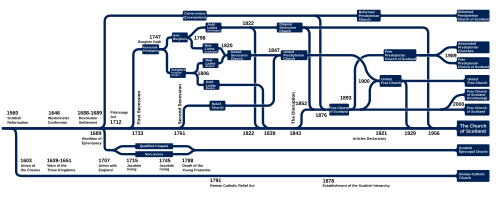The United Presbyterian Church (1847–1900) was a Scottish Presbyterian denomination. It was formed in 1847 by the union of the United Secession Church and the Relief Church, and in 1900 merged with the Free Church of Scotland to form the United Free Church of Scotland, which in turn united with the Church of Scotland in 1929. For most of its existence the United Presbyterian Church was the third largest Presbyterian Church in Scotland, and stood on the liberal wing of Scots Presbyterianism. The Church's name was often abbreviated to the initials U.P.

Ebenezer Erskine was a Scottish minister whose actions led to the establishment of the Secession Church.

Ralph Erskine was a Scottish churchman.
Thomas Gillespie was a Scottish minister of the Church of Scotland. He was founder of the Synod of Relief. Thomas Gillespie, born in 1708, at Clearburn, Duddingston, was the son of a well-to-do brewer and bonnet-laird — the only son of a second marriage. An interview with Thomas Boston, arranged by his mother, turned his thoughts to the ministry. On the completion of his Arts course in Edinburgh, he entered the Divinity Hall. After some months, however, he left for the Divinity Hall of the Secession Church in Perth. A few weeks’ experience of its narrowness being more than enough, he betook himself to Northampton to complete his studies under Philip Doddridge. He was ordained by a "classis" of the English Presbyterians. Presented and called to Carnock, he was inducted by the Presbytery of Dunfermline in 1741. In the early years of his ministry he was a leader in the Cambuslang and Kilsyth Revivals, and became a trusted correspondent of George Whitfield and Jonathan Edwards. Taking his stand, with the majority of the Presbytery, against the Inverkeithing Intrusion, he was summarily deposed by the General Assembly of 1752. In 1761, with two other ministers and their flocks, he formed a new body — the Presbytery of Relief, which had attained a quite considerable place in many parts of Scotland, by the time of his death in 1774.

The Anti-Burghers were opponents of the Burgher Oath on theological grounds.

Thomas M'Crie was a Presbyterian minister and church historian. He was a Scottish Secession minister who joined the Free Church of Scotland and served as the Moderator of the General Assembly to that church 1856/57.
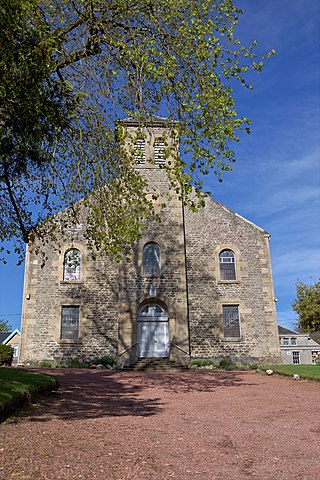
Abbeygreen Church is a congregation of the Free Church of Scotland in the small town of Lesmahagow, Lanarkshire. As a Christian congregation, it is presbyterian and reformed; holding the Word of God, the Holy Bible, as the supreme rule of life and doctrine and the Westminster Confession of Faith as a sub-ordinate standard, which helps explain the doctrines of the Christian faith. Being Presbyterian, it serves as part of the Free Church of Scotland Presbytery of Glasgow and seeks to faithfully serve God in Lesmahagow and the surrounding area. Having a missional outlook it is involved with a number of missionary organizations including, but not only, UFM Worldwide and Rose of Sharon Ministries, and helps with the organization and support of the Scottish Reformed Conference.

The First Secession was an exodus of ministers and members from the Church of Scotland in 1733. Those who took part formed the Associate Presbytery and later the United Secession Church. They were often referred to as Seceders.
James Baine (1710–1790) was one of the ministers of the secession from the Church of Scotland which took the name of the Relief Church.

James Fisher (1697–1775) was one of the founders of the Scottish Secession church. He was born at Barr, on 23 January 1697, the second son of Thomas Fisher, minister of Rhynd. He was educated at University of Glasgow. He was licensed by the Presbytery of Perth on 31 October 1722 and subsequently called and ordained on 23 December 1725. He dissented and joined with his father-in-law Ebenezer Erskine in his appeal and complaint to the Assembly of 1733. He was one of the four original members of the Associate Presbytery founded at Gairney Bridge on 6 December 1733. He was deposed by the General Assembly on 15 May 1740, but continued to preach in the parish church till 13 August 1741, when he was forcibly ejected on a sheriff's warrant. He then preached in a tent on Kinclaven brae during the time he remained in the district. On 8 October 1741 he became minister of Shuttle Street Associate Congregation, Glasgow. He was deposed by the Associate (Antiburgher) Synod on 4 August 1748 over the question of the Burgess Oath. He was appointed Professor of Divinity by the Associate (Burgher) Synod in 1749. He died on 28 September 1775.

Scottish religion in the eighteenth century includes all forms of religious organisation and belief in Scotland in the eighteenth century. This period saw the beginnings of a fragmentation of the Church of Scotland that had been created in the Reformation and established on a fully Presbyterian basis after the Glorious Revolution. These fractures were prompted by issues of government and patronage, but reflected a wider division between the Evangelicals and the Moderate Party. The legal right of lay patrons to present clergymen of their choice to local ecclesiastical livings led to minor schisms from the church. The first in 1733, known as the First Secession and headed by figures including Ebenezer Erskine, led to the creation of a series of secessionist churches. The second in 1761 led to the foundation of the independent Relief Church.
The United Presbyterian Church, Thurso was a parish church of the United Presbyterian Church of Scotland, now extinct, in Thurso, Caithness. The original church was built in 1777 with seating for 590, and a newer building was erected around 1801.
William Cruden (1726–1785) was a Scottish minister and author.

Thomas Boston, the younger (1713–1767) was a Scottish minister of the Relief Church.
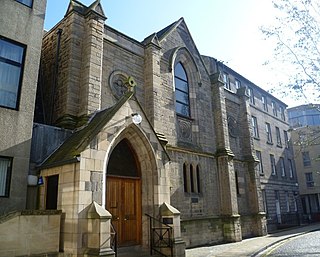
The King Khalid Building is an event space in the Southside, Edinburgh, Scotland, owned and operated by the Royal College of Surgeons of Edinburgh. The building was constructed Roxburgh Free Church in 1847 and converted to its current use in 1982.
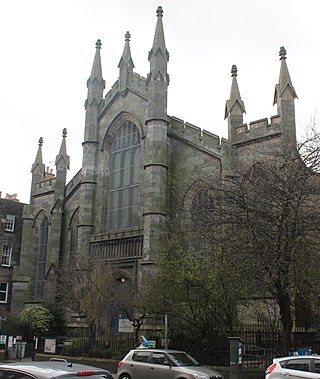
The Southside Community Centre is a community centre in the Southside, Edinburgh, Scotland, United Kingdom. The centre opened in 1986 and occupies the former Nicolson Street Church, which was completed in 1820.
Patrick Hutchison (1741–1802) was a Presbyterian minister who produced the first systematic definition of the beliefs of the Relief Church in Scotland.
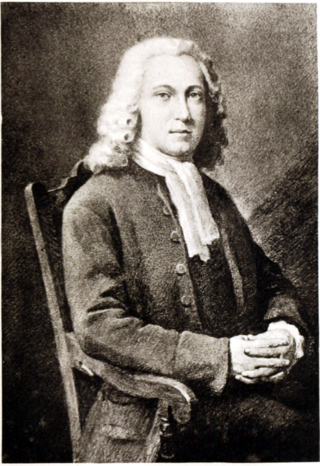
Alexander Moncrieff (1695–1761) was a Scottish Presbyterian minister. He was the son of Matthew Moncrieff of Culfargie and Margaret Mitchell. His paternal grandfather, also Alexander Moncrieff, was a well known minister of Scoonie. He was educated at Perth Grammar School and St Leonard's College, St Andrews. He graduated with an M.A. and then attended a course of theology at Leiden under John a Marck and Wesselius. He was licensed by the Presbytery of Perth 29 April 1719 and called 26 April, and by Presbytery jure devoluto, 24 August, and ordained 14 September 1720. He sympathised with Ebenezer Erskine, and the Commission of Assembly on 9 August 1733 suspended him and three associates from the exercise of their ministry. As they refused obedience, on 16 November the Commission declared them no longer ministers of the Church. Moncrieff with his brethren met at Gairney Bridge 6 December 1733, and formed the Associate Presbytery. The General Assembly of 1734 reponed him to office. From 1734 to 1740 he preached from the parish church pulpit, occupied the manse, received the stipend, yet protested against the jurisdiction of the Church, declined to attend Presbytery meetings, or in any way to be amenable to ecclesiastical authority. He was finally deposed by the Assembly on 15 May 1740. He was appointed by the Associate Presbytery Professor of Divinity in February 1742. He joined with those who were against the Burgess Oath, and was one of the founders of the General Associate Synod 10 April 1747. He died on 7 October 1761.
William Wilson was born in Glasgow, on 9 November 1690. He was the son of Gilbert Wilson, proprietor of a small estate near East Kilbride.. William Wilson's mother was Isabella, daughter of Ramsay of Shielhill. William was named after William of Orange and was educated at University of Glasgow, graduating with an M.A. in 1707. He was licensed by the Presbytery of Dunfermline on 23 September 1713 and called unanimously on 21 August 1716. He was ordained on 1 November 1716. He had a call to Rhynd, but was continued by the Presbytery in Perth. Associating with the supporters of the Marrow of Modern Divinity, he with three others Ebenezer Erskine, Alexander Moncrieff, and James Fisher laid the foundation of the Secession Church, for which they were suspended by the Commission of Assembly 9 August, and declared no longer ministers of the Church 12 November 1733. He was deposed by the Assembly 15 May 1740. He and his people erected a meeting-house, and the Associate Presbytery appointed him their Professor of Divinity, 5 November 1736, but he sank under his contentions and labours and died 8 October 1741. He is said to have combined "the excellencies of both Erskines, with excellencies peculiar to himself."
Thomas Nairn was a controversial Scottish Presbyterian minister. Although he served in several Presbyterian denominations perhaps his most important contribution to church history was his role in setting up the organisation which eventually became the Reformed Presbyterian Church. Although his stay with that religious community was relatively short he was acknowledged, by right of his valid ordination, to have the authority, along with John M'Millan, to form a legitimate presbytery and in so doing to be able to ordain others to the offices of the church. Before Nairn's arrival M'Millan had for more than 36 years been the only minister in what was essentially a small denomination known as the United Societies. Nairn had previously been a minister in the Associate Presbytery of the First Seceders, although he started and ended his days in the Church of Scotland.
